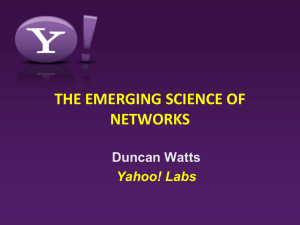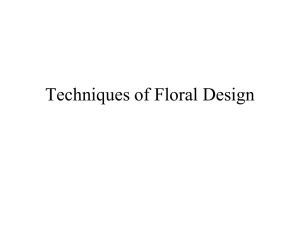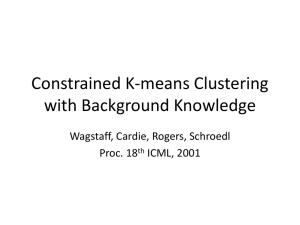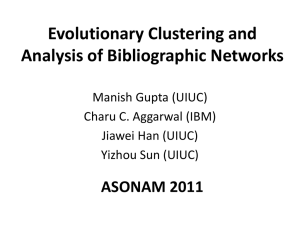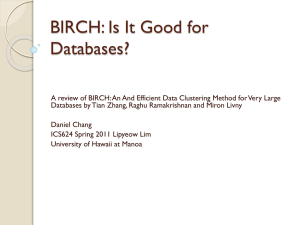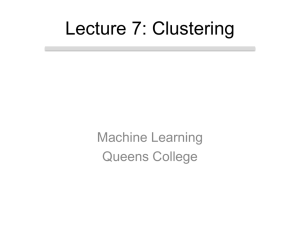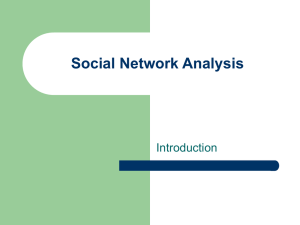Graph Cluster Analysis
advertisement
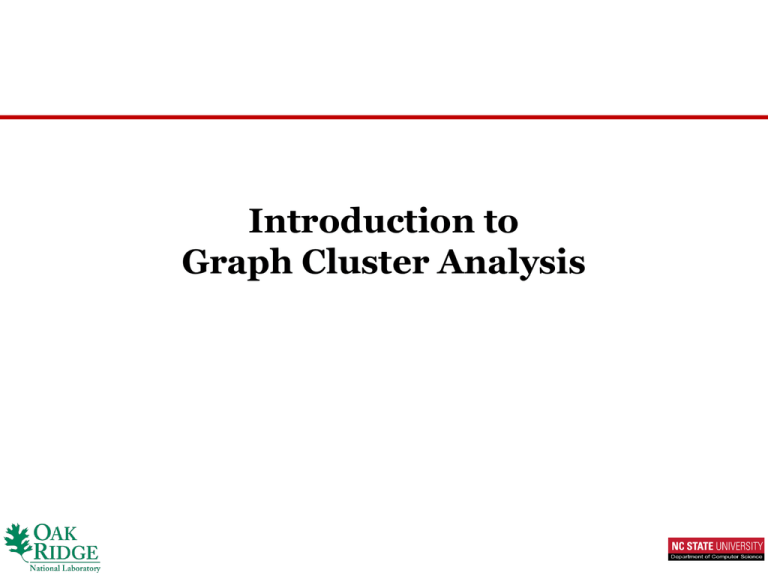
Introduction to
Graph Cluster Analysis
Outline
• Introduction to Cluster Analysis
• Types of Graph Cluster Analysis
• Algorithms for Graph Clustering
k-Spanning Tree
Shared Nearest Neighbor
Betweenness Centrality Based
Highly Connected Components
Maximal Clique Enumeration
Kernel k-means
• Application
2
Outline
• Introduction to Clustering
• Introduction to Graph Clustering
• Algorithms for Graph Clustering
k-Spanning Tree
Shared Nearest Neighbor
Betweenness Centrality Based
Highly Connected Components
Maximal Clique Enumeration
Kernel k-means
• Application
3
What is Cluster Analysis?
The process of dividing a set of input data into possibly
overlapping, subsets, where elements in each subset are
considered related by some similarity measure
2 Clusters
3 Clusters
4
Applications of Cluster Analysis
• Summarization
– Provides a macro-level view
of the data-set
Clustering precipitation
in Australia
From Tan, Steinbach, Kumar
Introduction To Data Mining,
Addison-Wesley, Edition 1
5
Outline
• Introduction to Clustering
• Introduction to Graph Clustering
• Algorithms for Graph Clustering
k-Spanning Tree
Shared Nearest Neighbor
Betweenness Centrality Based
Highly Connected Components
Maximal Clique Enumeration
Kernel k-means
• Application
6
What is Graph Clustering?
• Types
– Between-graph
• Clustering a set of graphs
– Within-graph
• Clustering the nodes/edges of a single graph
7
Between-graph Clustering
Between-graph clustering methods divide a set of
graphs into different clusters
E.g., A set of graphs representing chemical compounds can
be grouped into clusters based on their structural similarity
8
Within-graph Clustering
Within-graph clustering methods divides the nodes
of a graph into clusters
E.g., In a social networking graph, these clusters could
represent people with same/similar hobbies
Note: In this chapter we will look at different algorithms to
perform within-graph clustering
9
Outline
• Introduction to Clustering
• Introduction to Graph Clustering
• Algorithms for Within Graph Clustering
k-Spanning Tree
Shared Nearest Neighbor
Betweenness Centrality Based
Highly Connected Components
Maximal Clique Enumeration
Kernel k-means
• Application
10
k-Spanning Tree
2
1
3
2
3
2
4
5
k-Spanning
Tree
4
k groups
of
non-overlapping
vertices
Minimum Spanning Tree
k
STEPS:
• Obtains the Minimum Spanning Tree (MST) of input graph G
• Removes k-1 edges from the MST
• Results in k clusters
11
What is a Spanning Tree?
A connected subgraph with no cycles that includes all
vertices in the graph
G
2
1
7
3
2
3
4
5
2
4
1
6
5
4
2
3
6
2
7
2
4
5
Weight = 17
Note: Weight can represent either distance or similarity
between two vertices or similarity of the two vertices
12
What is a Minimum Spanning Tree
(MST)?
The spanning tree of a graph with the minimum possible sum
of edge weights, if the edge weights represent distance
G
Weight
= 11
2
2
3
1
7
3
2
4
5
6
2
4
Note: maximum
possible sum of edge
weights, if the edge
weights represent
similarity
3
1
5
2
3
4
2
1
4
4
2
3
2
1
2
3
2
7
2
4
2
6
5
5
4
5
Weight = 13
4
5
Weight = 17
13
Algorithm to Obtain MST
Prim’s Algorithm
Given Input Graph
G
2
3 6
1
7
3
2
2
4
4
5
Select Vertex Randomly
e.g., Vertex 5
Initialize Empty Graph T
with Vertex 5
T
5
5
5
4
Repeat until all vertices are added to T
Add X to T
T
From L select the
edge X with
minimum weight
5
5
4
4
4
Select a list of edges L
from G such that at
most ONE vertex of each
edge is in T
6
3
5
5
4
4
k-Spanning Tree
2
1
3
2
3
2
Remove k-1 edges
with highest weight
5
4
4
Note: k – is the
number of
clusters
Minimum Spanning Tree
E.g., k=3
E.g., k=3
1
3
3
5
2
2
1
2
4
3 Clusters
3
2
4
5
4
15
k-Spanning Tree R-code
•
•
•
•
•
•
•
•
library(GraphClusterAnalysis)
library(RBGL)
library(igraph)
library(graph)
data(MST_Example)
G = graph.data.frame(MST_Example,directed=FALSE)
E(G)$weight=E(G)$V3
MST_PRIM = minimum.spanning.tree(G,weights=G$weight, algorithm = "prim")
•
•
•
•
OutputList = k_clusterSpanningTree(MST_PRIM,3)
Clusters = OutputList[[1]]
outputGraph = OutputList[[2]]
Clusters
16
Outline
• Introduction to Clustering
• Introduction to Graph Clustering
• Algorithms for Within Graph Clustering
k-Spanning Tree
Shared Nearest Neighbor Clustering
Betweenness Centrality Based
Highly Connected Components
Maximal Clique Enumeration
Kernel k-means
• Application
17
Shared Nearest Neighbor Clustering
Shared Nearest Neighbor Graph (SNN)
0
2
2 2
1
2
2 3
2
3
1
4
1
Shared
Nearest
Neighbor
Clustering
Groups
of
non-overlapping
vertices
τ
STEPS:
• Obtains the Shared Nearest Neighbor Graph (SNN) of input graph G
• Removes edges from the SNN with weight less than τ
18
What is Shared Nearest Neighbor?
(Refresher from Proximity Chapter)
Shared Nearest Neighbor is a proximity measure and denotes the
number of neighbor nodes common between any given pair of nodes
u
v
19
𝑺𝒉𝒂𝒓𝒆𝒅 𝑵𝒆𝒂𝒓𝒆𝒔𝒕 𝑵𝒆𝒊𝒈𝒉𝒃𝒐𝒓𝒔
Shared Nearest Neighbor (SNN)
Graph
Given input graph G, weight each edge (u,v) with the number of shared
nearest neighbors between u and v
SNN
G
0
2
0
4
1
3
2
2 2
1
2
2 3
1
3
Node 0 and Node 1 have 2 neighbors
in common: Node 2 and Node 3
20
1
4
1
Shared Nearest Neighbor Clustering
Jarvis-Patrick Algorithm
SNN graph of input graph G
0
2
2 2
1
2
2 3
2
3
1
4
1
If u and v share more than τ
neighbors
Place them in the same
cluster
E.g., τ =3
0
2
4
1
3
21
SNN-Clustering R code
•
•
•
•
•
•
•
library(GraphClusterAnalysis)
library(RBGL)
library(igraph)
library(graph)
data(SNN_Example)
G = graph.data.frame(SNN_Example,directed=FALSE)
tkplot(G)
•
•
Output = SNN_Clustering(G,3)
Output
22
Outline
• Introduction to Clustering
• Introduction to Graph Clustering
• Algorithms for Within Graph Clustering
k-Spanning Tree
Shared Nearest Neighbor Clustering
Betweenness Centrality Based
Highly Connected Components
Maximal Clique Enumeration
Kernel k-means
• Application
23
What is Betweenness Centrality?
(Refresher from Proximity Chapter)
Betweenness centrality quantifies the degree to which a vertex
(or edge) occurs on the shortest path between all the other
pairs of nodes
Two types:
– Vertex Betweenness
– Edge Betweenness
24
Vertex Betweenness
The number of shortest paths in the graph G that
pass through a given node S
G
E.g., Sharon is likely a liaison between NCSU and DUKE and
hence many connections between DUKE and NCSU pass
through Sharon
25
Edge Betweenness
The number of shortest paths in the graph G that
pass through given edge (S, B)
NCSU
E.g., Sharon and
Bob both study at
NCSU and they are
the only link
between NY
DANCE and CISCO
groups
Vertices and Edges with high Betweenness
form good starting points to identify
clusters
26
Vertex Betweenness Clustering
Given Input graph G
Repeat until
highest vertex
betweenness ≤ μ
Betweenness for each vertex
1. Disconnect graph at
selected vertex (e.g.,
vertex 3 )
2. Copy vertex to both
Components
Select vertex v with
the highest
betweenness
E.g., Vertex 3 with
value 0.67
27
Vertex Betweenness Clustering
R code
•
•
•
•
•
•
•
library(GraphClusterAnalysis)
library(RBGL)
library(igraph)
library(graph)
data(Betweenness_Vertex_Example)
G = graph.data.frame(Betweenness_Vertex_Example,directed=FALSE)
betweennessBasedClustering(G,mode="vertex",threshold=0.2)
28
Edge-Betweenness Clustering
Girvan and Newman Algorithm
Given Input Graph G
Repeat until
highest edge
betweenness ≤ μ
Betweenness for each edge
Disconnect graph at
selected edge
(E.g., (3,4 ))
Select edge with
Highest
Betweenness
E.g., edge (3,4) with
value 0.571
29
Edge Betweenness Clustering
R code
•
•
•
•
•
•
•
library(GraphClusterAnalysis)
library(RBGL)
library(igraph)
library(graph)
data(Betweenness_Edge_Example)
G = graph.data.frame(Betweenness_Edge_Example,directed=FALSE)
betweennessBasedClustering(G,mode="edge",threshold=0.2)
30
Outline
• Introduction to Clustering
• Introduction to Graph Clustering
• Algorithms for Within Graph Clustering
k-Spanning Tree
Shared Nearest Neighbor Clustering
Betweenness Centrality Based
Highly Connected Components
Maximal Clique Enumeration
Kernel k-means
• Application
31
What is a Highly Connected Subgraph?
• Requires the following definitions
– Cut
– Minimum Edge Cut (MinCut)
– Edge Connectivity (EC)
32
Cut
• The set of edges whose removal disconnects a graph
7
6
7
6
Cut = {(3,5),(4,2)}
8
8
0
5
0
5
1
1
4
4
3
7
6
2
2
3
8
0
5
1
Cut = {(0,1),(1,2),(1,3}
4
3
2
33
Minimum Cut
The minimum set of edges whose removal disconnects
a graph
MinCut = {(3,5),(4,2)}
7
6
7
6
8
8
0
5
0
5
1
1
4
4
3
2
3
2
34
Edge Connectivity (EC)
• Minimum NUMBER of edges that will disconnect
a graph
MinCut = {(3,5),(4,2)}
7
6
Edge Connectivity
8
0
5
1
4
3
EC = | MinCut|
= | {(3,5),(4,2)}|
=2
2
35
Highly Connected Subgraph (HCS)
A graph G =(V,E) is highly connected if EC(G)>V/2
G
7
6
8
0
5
1
4
3
EC(G) > V/2
2 > 9/2
2
G is NOT a highly connected subgraph
36
HCS Clustering
Return G
Given Input graph G
7
6
8
0
5
4
Find the
Minimum Cut
MinCut (G)
1
3
2
(3,5),(4,2)}
YES
Is EC(G)> V/2
Process Graph G1
NO
Process Graph G2
Divide G
using MinCut
G1
G2
37
HCS Clustering R code
•
•
•
•
•
•
•
library(GraphClusterAnalysis)
library(RBGL)
library(igraph)
library(graph)
data(HCS_Example)
G = graph.data.frame(HCS_Example,directed=FALSE)
HCSClustering(G,kappa=2)
38
Outline
• Introduction to Clustering
• Introduction to Graph Clustering
• Algorithms for Within Graph Clustering
k-Spanning Tree
Shared Nearest Neighbor Clustering
Betweenness Centrality Based
Highly Connected Components
Maximal Clique Enumeration
Kernel k-means
• Application
39
What is a Clique?
A subgraph C of graph G with edges between
all pairs of nodes
C
G
6
7
6
8
5
7
5
Clique
4
40
What is a Maximal Clique?
A maximal clique is a clique that is not part
of a larger clique.
6
Clique
7
7
6
8
5
5
4
6
7
Maximal Clique
8
5
41
Maximal Clique Enumeration
Bron and Kerbosch Algorithm
Input Graph G
BK(C,P,N)
C - vertices in current clique
P – vertices that can be added to C
N – vertices that cannot be added to C
Condition:
If both P and N are empty – output C as
maximal clique
42
Maximal Clique R code
•
•
•
•
•
•
•
•
library(GraphClusterAnalysis)
library(RBGL)
library(igraph)
library(graph)
data(CliqueData)
G = graph.data.frame(CliqueData,directed=FALSE)
tkplot(G)
maximalCliqueEnumerator (G)
43
Outline
• Introduction to Clustering
• Introduction to Graph Clustering
• Algorithms for Within Graph Clustering
k-Spanning Tree
Shared Nearest Neighbor Clustering
Betweenness Centrality Based
Highly Connected Components
Maximal Clique Enumeration
Kernel k-means
• Application
44
What is k-means?
• k-means is a clustering algorithm applied to vector
data points
• k-means recap:
– Select k data points from input as centroids
1. Assign other data points to the nearest centroid
2. Recompute centroid for each cluster
3. Repeat Steps 1 and 2 until centroids don’t change
45
k-means on Graphs
Kernel K-means
• Basic algorithm is the same as k-means on Vector data
• We utilize the “kernel trick” (recall Kernel Chapter)
• “kernel trick” recap
– We know that we can use within-graph kernel functions to
calculate the inner product of a pair of vertices in a userdefined feature space.
– We replace the standard distance/proximity measures used in
k-means with this within-graph kernel function
46
Outline
• Introduction to Clustering
• Introduction to Graph Clustering
• Algorithms for Within Graph Clustering
k-Spanning Tree
Shared Nearest Neighbor Clustering
Betweenness Centrality Based
Highly Connected Components
Maximal Clique Enumeration
Kernel k-means
• Application
47
Application
• Functional modules in protein-protein interaction
networks
• Subgraphs with pair-wise interacting nodes => Maximal
cliques
R-code
• library(GraphClusterAnalysis)
• library(RBGL)
• library(igraph)
• library(graph)
• data(YeasPPI)
• G = graph.data.frame(YeasPPI,directed=FALSE)
• Potential_Protein_Complexes = maximalCliqueEnumerator (G)
• Potential_Protein_Complexes
48
